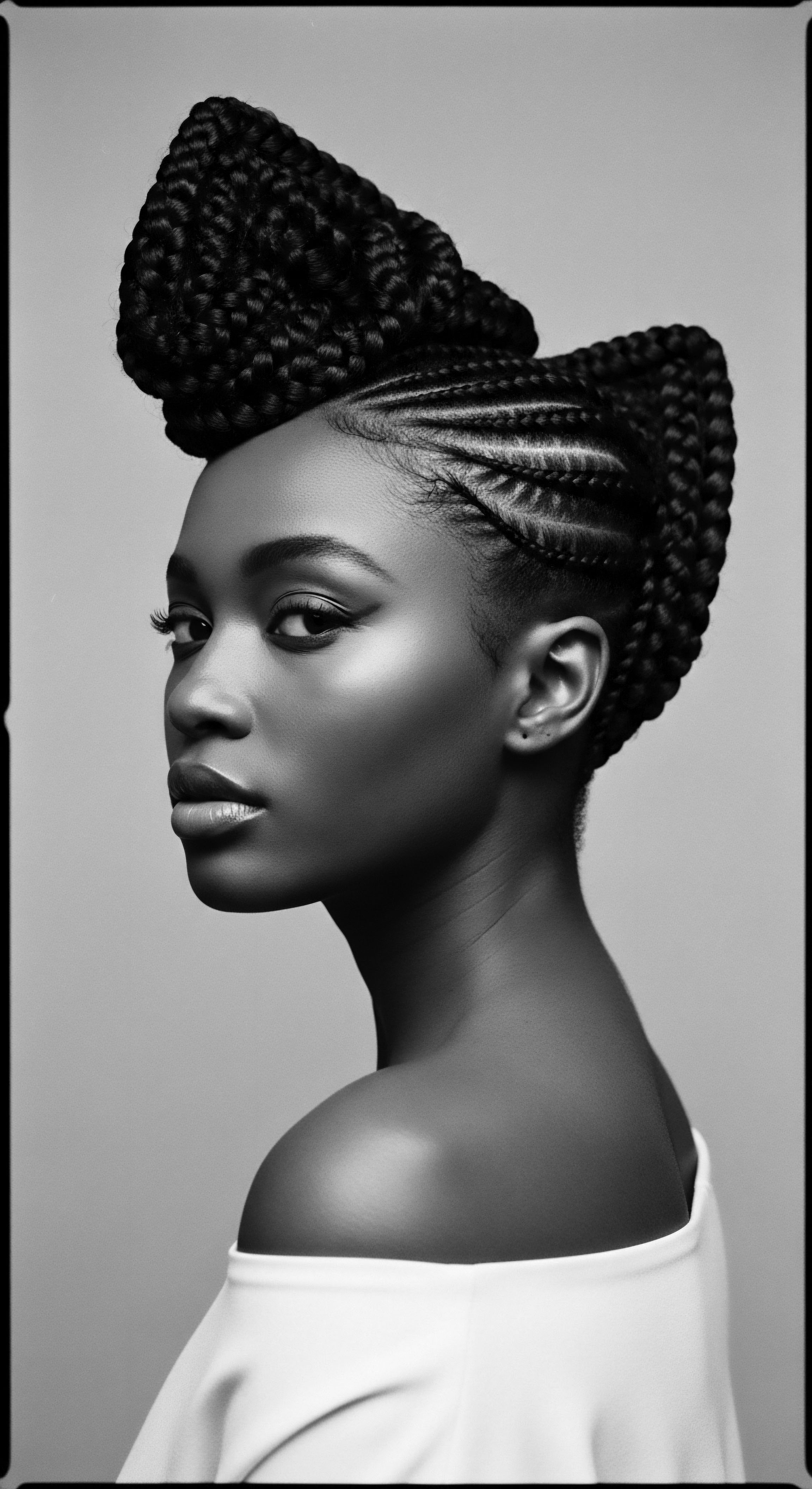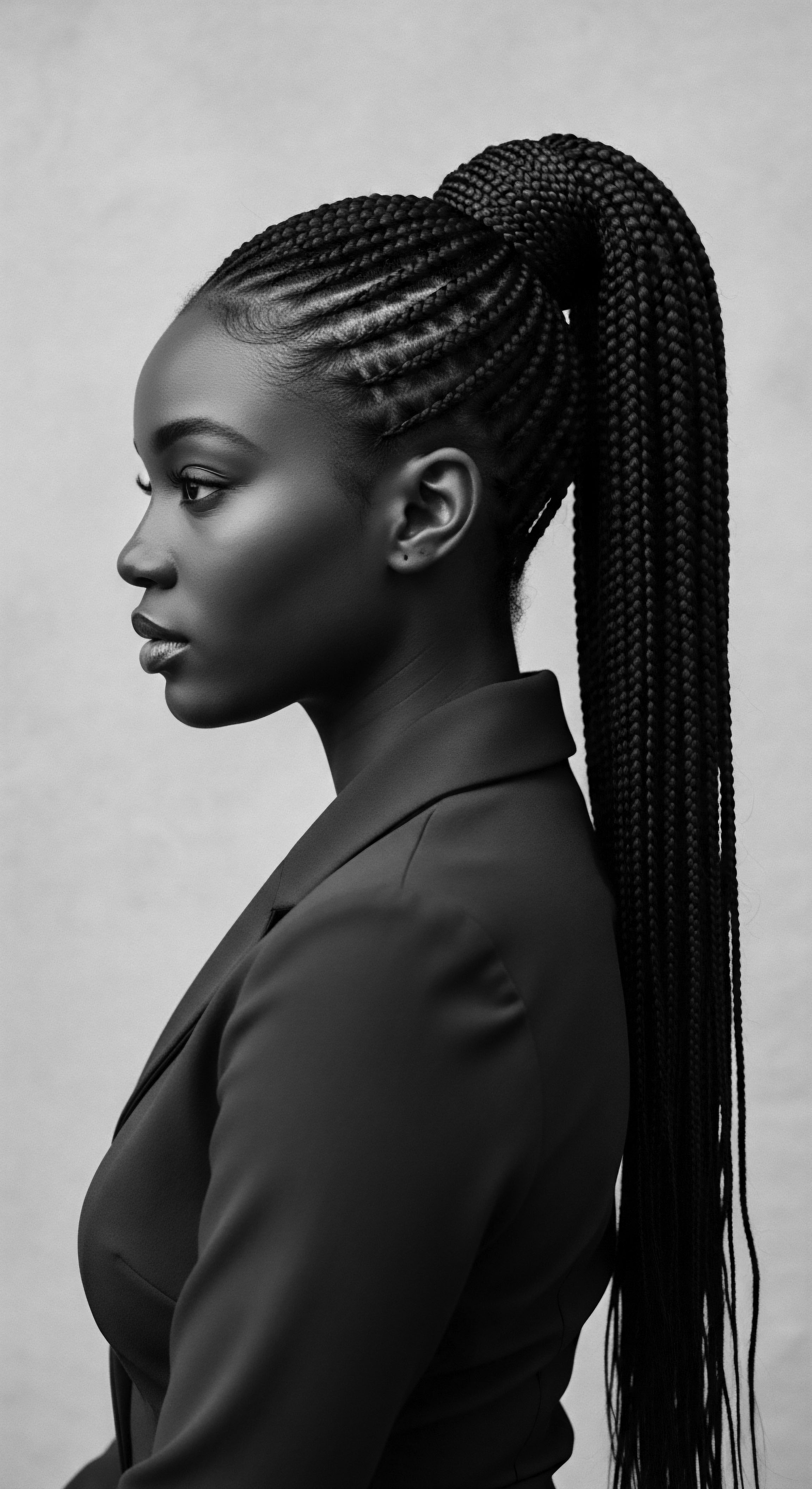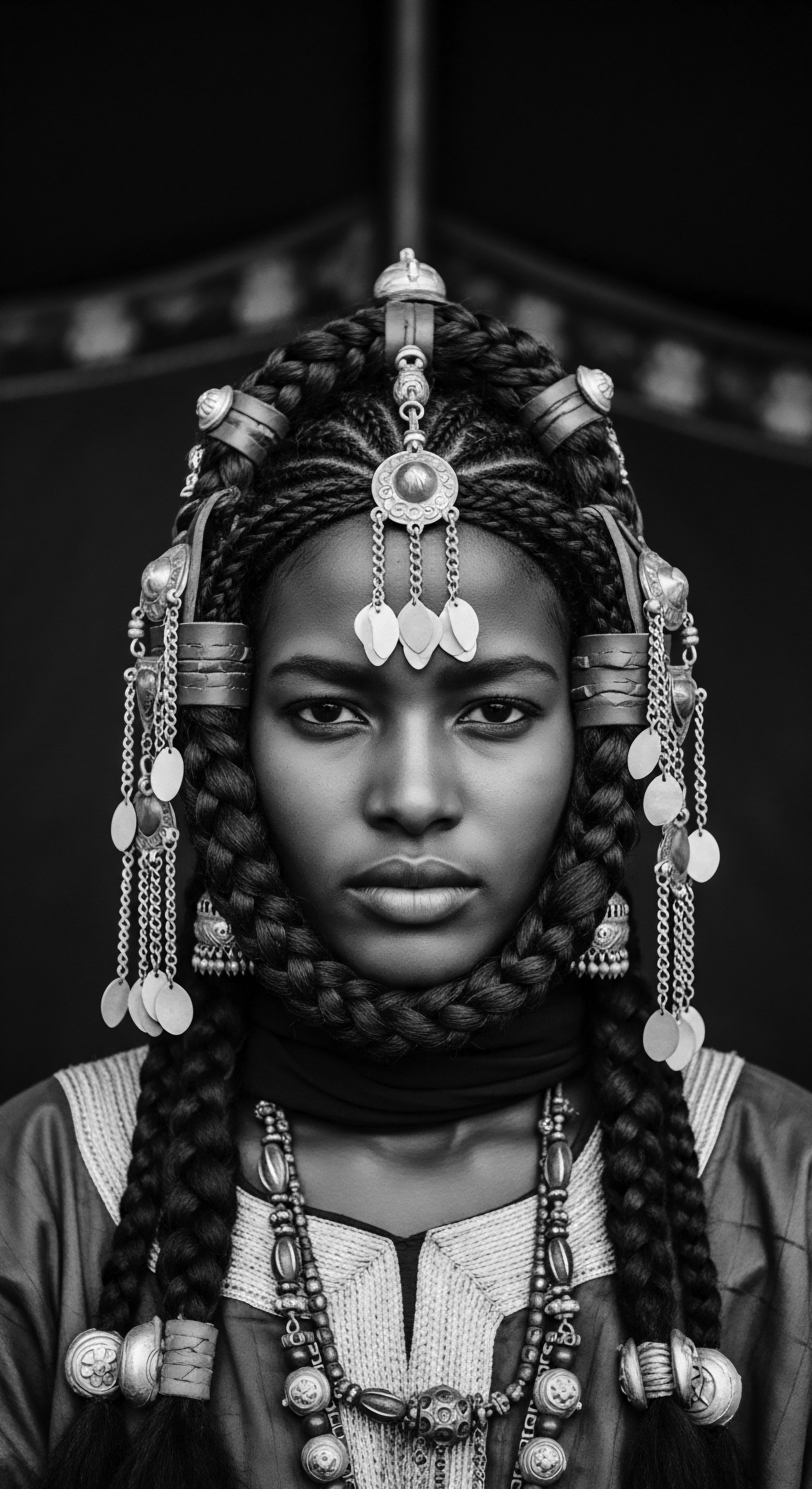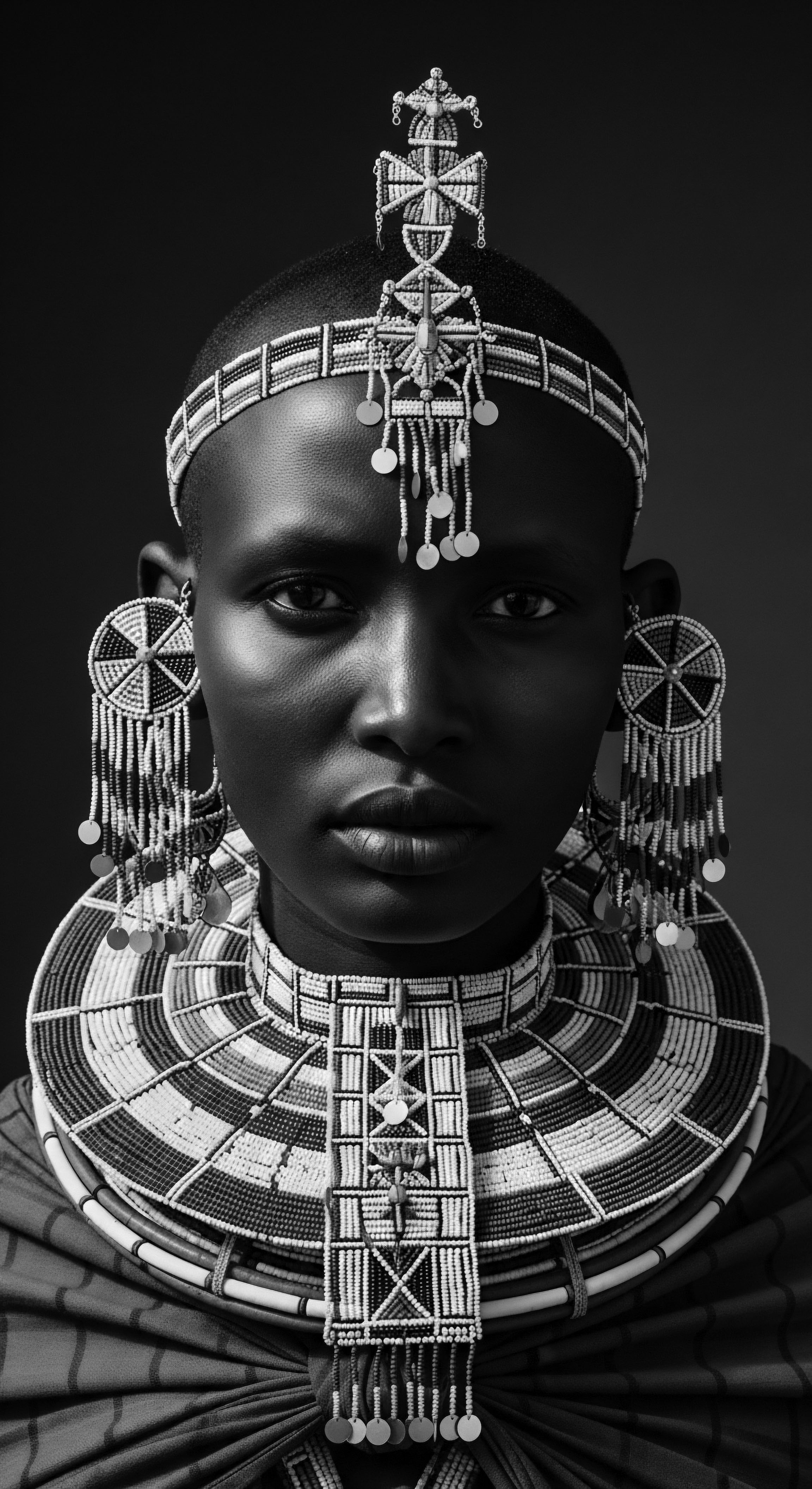
Fundamentals
The Igbo Hairstyles, in their simplest delineation, represent far more than mere aesthetic arrangements of hair; they are profound cultural statements, visual narratives etched upon the scalp. For the Igbo people of Nigeria, hair is regarded as a crowning glory, a living canvas for personal expression and communal identity. These styles communicate intricate details about an individual’s journey through life, their standing within society, and their connection to ancestral practices. The very act of styling, often communal, becomes a ritual of shared heritage, a moment of intergenerational knowledge transfer.
The core meaning of Igbo Hairstyles extends beyond adornment, serving as a powerful visual language. They speak of age, marital status, social standing, occupation, and even a person’s mood or spiritual inclinations. The patterns, whether bold lines or delicate curves, are not arbitrary; they echo principles of art and design deeply embedded in Igbo aesthetic traditions. This artistry transforms textured hair into a dynamic medium, allowing for expressions that are both beautiful and deeply symbolic.
Igbo Hairstyles are not simply decorative; they are living chronicles of identity, status, and community, intricately woven into the fabric of textured hair heritage.

Early Expressions and Elemental Forms
In ancient times, the foundations of Igbo Hairstyles were rooted in elemental biology and natural resources. The inherent texture of Black hair, with its unique coiling and kinking patterns, lends itself exceptionally to intricate braiding, twisting, and threading techniques. This inherent quality of textured hair allowed for the creation of durable, elaborate styles that could signify complex meanings.
Early practices involved the careful manipulation of hair directly from the scalp, utilizing natural oils, herbs, and other botanical elements for conditioning and hold. These ingredients, often sourced from the surrounding environment, formed the basis of ancestral hair care rituals, linking the physical act of styling to the land and its bounty.
- Ishi Owu ❉ This threaded hairstyle, a practice spanning centuries, involves wrapping sections of hair tightly with black thread. It is often associated with young, unmarried girls, symbolizing youthfulness and the protective qualities it offers to the hair strands.
- Nkpukpo Isi ❉ A form of tight cornrow braiding, often seen on young Igbo women, creating diverse patterns close to the scalp. This style could be enhanced with beads and other decorative pieces, reflecting youthful vibrancy.
- Etutu ❉ Characterized by large buns or rolls positioned atop the head, this style was traditionally worn by married women or those of higher social standing in certain Igbo communities, symbolizing maturity and motherhood.

Intermediate
The intermediate understanding of Igbo Hairstyles deepens our appreciation for their historical and cultural significance, moving beyond basic identification to grasp the profound ways these coiffures functioned within society. They represent a sophisticated system of non-verbal communication, a visual lexicon understood within Igbo communities. The artistry involved, often passed down through generations, highlights a deep respect for hair as a sacred aspect of self, an extension of one’s lineage and spirit. This is particularly salient when considering the broader context of textured hair heritage, where hair has consistently served as a powerful marker of identity and resilience across Black and mixed-race experiences.

Cultural Cartography ❉ Hair as a Map of Life
Igbo Hairstyles acted as a veritable cultural cartography, mapping an individual’s life journey and social standing. A woman’s hairstyle could instantly convey her age, whether she was a maiden, newly married, or a respected elder. It could also denote her marital status, her social class, or even her occupation.
For instance, a widowed woman in some parts of Igboland traditionally shaved her hair during mourning, abstaining from elaborate styling to honor her late husband and signal her grief. This practice stands in stark contrast to the adorned heads of women celebrating festivals or rites of passage, where intricate designs and embellishments would be proudly displayed.
The very act of hair dressing was a communal affair, often performed by trusted friends or relatives. This shared experience underscored the social cohesion and familial bonds central to Igbo life. It was a time for storytelling, for transmitting wisdom, and for reinforcing community ties, demonstrating that hair care was not merely a personal grooming ritual but a collective cultural practice.
The intricate patterns of Igbo Hairstyles served as a complex social language, silently communicating status, life stage, and communal belonging.

The Evolution of Style ❉ Echoes of Time and Influence
The evolution of Igbo Hairstyles reflects the dynamic interplay between tradition and external influences. While ancient forms persisted, new styles emerged and adapted over time. The colonial era, however, presented a significant disruption.
European colonial rule often sought to dismantle traditional African cultural practices, labeling natural hair styles as ‘unruly’ or ‘undisciplined’. This cultural assault led to a decline in some traditional hairstyles, with the adoption of chemically relaxed hair and other Western styles becoming more prevalent in the late 20th century.
Despite these pressures, the resilience of Igbo hair culture is evident in the continued reverence for these styles, even as they undergo modern interpretations. The underlying principles of artistry, symbolism, and community care endure, a testament to the deep-seated value placed on hair within Igbo heritage.
| Aspect of Hair Practice Styling Techniques |
| Traditional Igbo Approach Intricate braiding, threading (Ishi Owu), twisting, coiling close to the scalp. |
| Contemporary Adaptations/Influences Relaxing, perming, use of weaves and extensions, fusion with Western styles. |
| Aspect of Hair Practice Adornments |
| Traditional Igbo Approach Cowries, beads, threads, palm kernels, feathers, bone ornaments. |
| Contemporary Adaptations/Influences Modern hair accessories, synthetic embellishments, often incorporating traditional motifs. |
| Aspect of Hair Practice Products Used |
| Traditional Igbo Approach Natural oils, herbs, plant-based dyes (e.g. uli for hair and body art). |
| Contemporary Adaptations/Influences Commercial hair products, chemical relaxers, synthetic conditioners, and modern hair dyes. |
| Aspect of Hair Practice Social Context |
| Traditional Igbo Approach Communal activity, signifying social status, age, marital status, and spiritual beliefs. |
| Contemporary Adaptations/Influences Personal expression, fashion statements, cultural pride, and diasporic connection, though communal aspects may be less prominent. |
| Aspect of Hair Practice This table highlights the enduring legacy of traditional Igbo hair practices, even as they have adapted to modern influences, maintaining a connection to ancestral wisdom. |

Academic
The academic interpretation of Igbo Hairstyles transcends mere description, delving into the complex semiotics, anthropological underpinnings, and historical trajectories that define their meaning and significance within the broader context of textured hair heritage. This analysis requires a rigorous examination of archaeological evidence, ethnographic accounts, and the socio-political forces that have shaped Igbo hair practices over centuries. The term “Igbo Hairstyles” thus refers to a dynamic system of aesthetic and communicative practices, meticulously crafted upon the human scalp, serving as a powerful, non-verbal repository of cultural knowledge, identity, and historical memory. This understanding is particularly pertinent when considering the global Black and mixed-race hair experience, where hair often becomes a contested site of self-definition against historical attempts at cultural erasure.

Archaeological Echoes and Ancient Meanings
The deep antiquity of elaborate hair styling in Igboland is attested by archaeological discoveries. The Igbo-Ukwu excavations, particularly those undertaken by Thurstan Shaw in 1959 and 1964, unearthed bronze artifacts dating back to the 9th century CE. Among these significant finds were human head pendants and figures depicting intricate coiffures, some adorned with loops where colored beads would have been attached.
These artifacts, stylistically distinct from later Benin and Ife bronzes, suggest a sophisticated and unique hair culture that flourished centuries before extensive European contact. The presence of such detailed hair representations on ceremonial objects implies that hairstyles held not only aesthetic value but also ritualistic and symbolic weight, perhaps signifying high status or spiritual roles within the ancient Nri Kingdom, a prominent Igbo polity.
Consider, for instance, the conical hairstyles with small loops found on some Igbo-Ukwu bronze pendants. These depictions are not merely decorative; they are material expressions of a complex cultural system where hair was an integral component of identity and social hierarchy. The scholarly examination of these ancient artifacts allows for a reconstruction of pre-colonial Igbo aesthetic ideals and the deep-seated meaning of hair as a form of non-verbal communication, connecting the past to the present through an unbroken lineage of textured hair artistry.
Archaeological findings from Igbo-Ukwu unveil an ancient lineage of sophisticated Igbo Hairstyles, demonstrating their profound symbolic and ritualistic roles in pre-colonial society.

The Semiotics of the Scalp ❉ Hair as a Communicative Medium
From an academic standpoint, Igbo Hairstyles function as a complex semiotic system, where each braid, twist, or adornment carries specific semantic content. This system allowed for nuanced communication within and across communities. As noted by Odike (2024), Igbo coiffures possessed a rich cultural and historical significance, often symbolizing status, age, marital status, and even spiritual beliefs.
For example, the Isi Ogo, an elaborate style characterized by intricate patterns and raised designs, was traditionally worn by chiefs or individuals of high status, often embellished with ornaments. Conversely, the shaving of hair by widows served as a clear visual signifier of mourning and a temporary withdrawal from certain social engagements.
The interplay of geometry and symbolism is evident in styles like the Uli Hairstyles, which drew inspiration from the traditional Uli body painting, incorporating geometric and flowing patterns directly into the hair. This artistic connection between hair and other forms of body art underscores a holistic approach to self-adornment, where the body, including the hair, served as a canvas for cultural expression and communal identity. This deliberate crafting of visual cues on textured hair speaks to a society that understood and utilized every aspect of appearance to convey meaning.

Case Study ❉ The Okuku Hairstyle and Its Transcultural Trajectories
While often associated with the Edo people, particularly as a coral-beaded crown for brides, the Okuku hairstyle also holds a fascinating, albeit sometimes debated, connection within Igbo cultural discourse. Some historical accounts suggest the Okuku style, or similar elaborate crested coiffures, existed within Igbo traditions, perhaps signifying royalty or specific social distinctions. This shared stylistic element across ethnic groups in Nigeria highlights the complex, interconnected nature of cultural exchange in the region.
The Okuku, with its majestic, often beaded structure, embodies the idea of hair as a crown, a literal and symbolic elevation of the individual. Its appearance in archaeological records and historical narratives from different groups underscores the fluidity of cultural practices and the shared heritage of elaborate hair adornment in West Africa.
The significance of the Okuku, whether in Edo or Igbo contexts, lies in its capacity to transform the wearer, marking them for special occasions or denoting elevated status. It serves as a compelling example of how hair, through its deliberate shaping and embellishment, becomes a performative element of identity, particularly for women. The debate around its precise origin or prevalence in specific Igbo communities also highlights the challenges of definitively attributing cultural practices in a region with long histories of interaction and influence. Nevertheless, the presence of such elaborate, crown-like hairstyles speaks to a universal reverence for hair as a powerful symbol of beauty, authority, and cultural pride within textured hair heritage.

The Tender Thread ❉ Hair Care as Embodied Knowledge
Beyond their aesthetic and symbolic functions, Igbo Hairstyles are intrinsically linked to ancestral practices of hair care, embodying a profound understanding of textured hair’s unique biological properties. Traditional Igbo hair care was not merely about styling; it was a holistic practice aimed at nurturing the hair and scalp, ensuring vitality and strength. Natural ingredients such as plant extracts, oils, and herbs were meticulously prepared and applied, demonstrating an empirical knowledge of their moisturizing, strengthening, and protective qualities. This deep respect for the hair’s inherent biology, coupled with traditional wisdom, formed the bedrock of hair wellness practices that preceded modern scientific understanding.
This embodied knowledge, passed down through generations, highlights a continuous thread of care that connects ancestral practices to contemporary understandings of textured hair. The efficacy of these traditional methods, often dismissed by colonial narratives, is increasingly validated by modern trichology, which recognizes the importance of moisture retention, scalp health, and gentle manipulation for kinky and coily hair types. The ancestral practice of threading, for instance, not only created beautiful styles but also served as a protective method to stretch and maintain hair length, minimizing breakage. This practical application of knowledge, interwoven with cultural meaning, underscores the sophisticated relationship between the Igbo people and their hair.
- Botanical Remedies ❉ Traditional Igbo hair care often involved the use of indigenous plants and their derivatives, such as shea butter for moisture and various herbs for scalp health, reflecting a deep ethnobotanical understanding.
- Protective Styling ❉ Techniques like threading and cornrowing were not solely for aesthetic appeal; they served to protect the hair from environmental damage and manipulation, thereby promoting growth and reducing breakage.
- Communal Grooming ❉ The social context of hair styling fostered intergenerational learning, with older women imparting their knowledge of hair care techniques and traditional remedies to younger generations.

Colonial Impact and Diasporic Resilience
The advent of colonialism profoundly disrupted traditional Igbo hair practices. European colonizers often imposed their aesthetic standards, denigrating indigenous hairstyles as ‘primitive’ or ‘unkept.’ This cultural subjugation led to a widespread adoption of Western hair practices, including chemical relaxers, which promised to straighten textured hair to conform to European ideals. This period marked a significant challenge to the continuity of ancestral hair traditions, as the colonial mindset sought to erase indigenous forms of self-expression. The forced cutting of hair during the transatlantic slave trade, for instance, served as a brutal act of dehumanization and cultural erasure, severing physical and symbolic ties to African heritage.
However, the resilience of textured hair heritage is undeniable. Despite centuries of oppression and cultural assimilation, Igbo Hairstyles, and African hair traditions more broadly, have persisted and re-emerged. In the diaspora, these styles became powerful symbols of resistance, cultural pride, and a reclaiming of identity. The contemporary natural hair movement, for example, can be seen as a continuation of this ancestral resilience, a collective decision to honor the inherent beauty and versatility of textured hair.
This journey from elemental biology and ancient practices to enduring traditions of care and community, and finally to a role in voicing identity and shaping futures, reflects the unbound helix of Black and mixed-race hair experiences. The cultural significance of these styles has not diminished; rather, it has transformed, adapting to new contexts while retaining its profound connection to ancestral roots.

Reflection on the Heritage of Igbo Hairstyles
The enduring spirit of Igbo Hairstyles, a testament to the textured hair heritage, echoes through generations, a silent yet vibrant language of identity and belonging. These styles, meticulously sculpted and adorned, are not relics of a distant past; they are living expressions, breathing with the ancestral wisdom that understands hair as a profound extension of self and community. Each braid, every coil, carries the whispers of matriarchs and the strength of a people who have consistently found ways to affirm their beauty and their stories, even in the face of profound historical disruptions. The careful attention to hair, the knowledge of nourishing botanicals, and the communal rituals of styling collectively form a tender thread that binds the past to the present, reminding us that true wellness begins with honoring our roots.
As we gaze upon the intricate patterns of an Isi Ogo or the protective coils of an Ishi Owu, we are not simply observing a fashion choice; we are witnessing a profound meditation on human ingenuity, cultural resilience, and the inherent artistry of textured hair. The journey of Igbo Hairstyles, from the earliest archaeological fragments of Igbo-Ukwu to the contemporary expressions seen across the globe, underscores a continuous narrative of adaptation and affirmation. This living library, etched on the very strands of our being, invites us to connect with a deeper understanding of beauty—one that is not dictated by fleeting trends but is grounded in the timeless wisdom of heritage, celebrating the unbound helix of our collective story.

References
- Cole, H. M. (1982). Igbo Arts and Culture. University of California Press.
- Isichei, E. (1976). A History of the Igbo People. Macmillan.
- Odike, C. (2024). The Cultural Significance of Traditional Igbo Coiffures ❉ Symbolism and Identity. Ozi Ikòrò .
- Omotos, A. (2018). The Significance of Hair in Ancient African Civilizations. Journal of Pan African Studies .
- Shaw, T. (1970). Igbo-Ukwu ❉ An account of archaeological discoveries in eastern Nigeria. Northwestern University Press.
- Talbot, P. A. (1932). Tribes of the Niger Delta. Frank Cass and Company Limited.
- Umahi, G. A. (2012). Cultural and Spiritual Implications of Head Covering Among the Igbo Christians of Southeastern Nigeria. African Seventh-day Adventist History, 1(1), 3-17.
